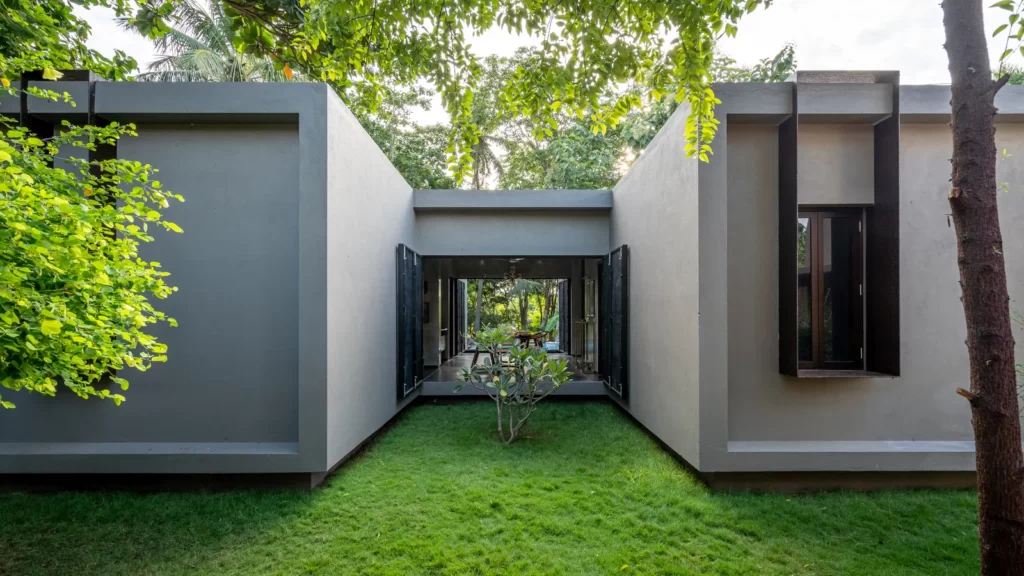Natural building materials often have a unique look and feel that can add character to any space. Many architects use natural building materials to construct unique homes that blend in with their surroundings.
What are natural building materials?
Natural building materials are materials that are found in nature and are used to construct buildings and other structures. They are typically more sustainable and environmentally friendly than synthetic materials because they are derived from natural sources and often require fewer resources to produce.
Some common natural building materials include:
- Wood: Wood is a versatile and renewable building material that has been used for centuries. It is strong, durable, and relatively easy to work with, and it can be used for a wide range of building applications, including framing, flooring, and roofing.
- Stone: Stone is a natural building material that has been used for thousands of years. It is strong, durable, and resistant to weathering, and it can be used for foundations, walls, and other structural elements.
- Clay: Clay is a natural building material that is made from the earth and water. It can be molded into various shapes and used to create bricks, tiles, and other building materials. Clay is a sustainable and energy-efficient building material because it can be fired at lower temperatures than other types of materials.
- Straw: Straw is a natural building material that is made from the stalks of grain crops, such as wheat, oats, and barley. It can be used to create straw bale homes, which are energy-efficient and sustainable.
- Cob: Cob is a natural building material that is made from a mixture of clay, sand, and straw. It can be molded into various shapes and used to create walls, floors, and other structural elements.
What is the most common natural material used in modern architecture?
The most common natural materials used in modern architecture are:
- Wood: Wood is a versatile and renewable building material that is widely used in modern architecture. It is strong, durable, and relatively easy to work with, and it can be used for a wide range of building applications, including framing, flooring, and roofing.

2. Concrete: Concrete is a mixture of cement, water, and aggregate (such as sand and gravel). It is a widely used building material in modern architecture because it is strong, durable, and relatively inexpensive.

3. Glass: Glass is a natural material that is made from sand, soda ash, and limestone. It is widely used in modern architecture because it allows natural light to enter a building and creates a sense of openness.

4. Stone: Stone is a natural building material that has been used for thousands of years. It is strong, durable, and resistant to weathering, and it can be used for foundations, walls, and other structural elements.

5. Clay: Clay is a natural building material that is made from the earth and water. It can be moulded into various shapes and used to create bricks, tiles, and other building materials. Clay is a sustainable and energy-efficient building material because it can be fired at lower temperatures than other types of materials.

Advantages and Disadvantages of Natural Building Materials in Architecture
There are both advantages and disadvantages to using natural building materials.
Some potential advantages of natural building materials include:
- Sustainability: Natural materials are often more sustainable than synthetic materials because they are derived from natural sources and require fewer resources to produce.
- Durability: Many natural materials, such as wood and stone, are strong and durable, which means they can last for many years with proper maintenance.
- Energy efficiency: Some natural materials, such as straw and clay, are energy-efficient because they can be fired at lower temperatures than synthetic materials.
- Aesthetics: Natural materials can add warmth and character to a building, and they can be used to create a wide range of design styles.
- Environmental impact: Natural materials tend to have a lower environmental impact than synthetic materials because they do not require as much energy to produce and they do not release as many harmful emissions.
Some potential disadvantages of natural building materials include:
- Cost: Natural materials can be more expensive than synthetic materials, especially if they are hard to source or require special processing.
- Maintenance: Natural materials may require more maintenance than synthetic materials because they are more susceptible to weathering and other types of wear and tear.
- Availability: Natural materials may be harder to find or more difficult to obtain than synthetic materials, depending on the location and availability of natural resources.
- Performance: Some natural materials may not perform as well as synthetic materials in certain applications, such as insulation or fire resistance.
How to use natural materials in architecture?
There are many ways to use natural construction materials in architecture, depending on the specific needs of the project and the availability of materials. Here are a few general tips for using natural materials in architecture:
- Choose materials that are appropriate for the climate: Natural materials can have different performance characteristics depending on the climate in which they are used. For example, materials that are well-suited for a hot, dry climate may not perform as well in a humid or cold climate. It’s important to choose natural materials that are appropriate for the climate in which the building will be located.
- Consider the performance characteristics of the materials: Different natural materials have different performance characteristics, such as strength, durability, insulation value, and fire resistance. It’s important to consider these characteristics when selecting natural materials for a building project.
- Use natural materials in combination with synthetic materials: Natural materials can be used in combination with synthetic materials to create a building that is both functional and sustainable. For example, you might use a combination of wood and steel to create a structural frame, or use clay tiles in combination with synthetic roofing material.
- Seek out local and/or sustainably sourced materials: Using local and/or sustainably sourced natural materials can help reduce the environmental impact of transportation
Why should we use natural materials in architecture?
There are several reasons why natural building materials should be used in architecture:
- Sustainability: Natural materials are often more sustainable than synthetic materials because they are derived from natural sources and require fewer resources to produce. Using natural materials can help reduce the environmental impact of building construction and reduce the demand for synthetic materials, which are often made from non-renewable resources.
- Durability: Many natural materials, such as wood and stone, are strong and durable, which means they can last for many years with proper maintenance. This can help reduce the need for frequent repairs and replacements, which can save money and resources over time.
- Energy efficiency: Some natural materials, such as straw and clay, are energy-efficient because they can be fired at lower temperatures than synthetic materials. Using these materials can help reduce energy consumption and greenhouse gas emissions during the construction process.
- Aesthetics: Natural materials can add warmth and character to a building, and they can be used to create a wide range of design styles. Using natural materials can help create a sense of connection to the environment and make a building feel more welcoming and inviting.
- Health benefits: Natural materials often have fewer chemicals and toxins than synthetic materials, which can make them healthier for people who live and work in buildings constructed with these materials.
Overall, using natural materials in architecture can have numerous benefits, including sustainability, durability, energy efficiency, aesthetics, and health benefits. By incorporating natural materials into building design, it is possible to create structures that are in harmony with the environment and promote a sense of well-being for the people who use them.
Recommended Reading: Fabulous Living Room Interior Decor Ideas for Every Home
Did you like this article?
Share it on any of the following social media channels below to give us your vote. Your feedback helps us improve.

















